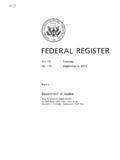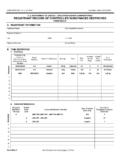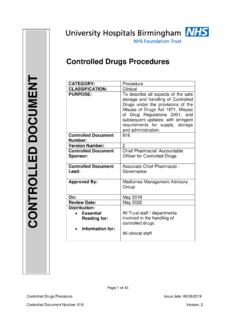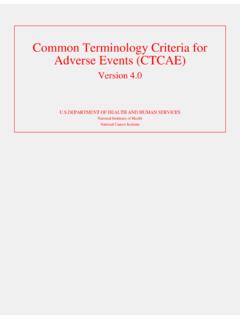Transcription of Withdrawn NIST Technical Series Publication
1 Date updated: July 3, 2019 Withdrawn NIST Technical Series Publication Warning Notice The attached Publication has been Withdrawn (archived), and is provided solely for historical purposes. It may have been superseded by another Publication (indicated below). Withdrawn Publication Series /Number NIST Interagency or Internal Report (NISTIR) 7298 Rev. 2 Title Glossary of Key Information Security Terms Publication Date(s) May 2013 Withdrawal Date July 3, 2019 Withdrawal Note NISTIR 7298 Rev. 2 is superseded in its entirety by NISTIR 7298 Rev. 3 Superseding Publication (s) (if applicable) The attached Publication has been superseded by the following Publication (s): Series /Number NIST Interagency or Internal Report (NISTIR) 7298 Rev. 3 Title Glossary of Key Information Security Terms Author(s) Celia Paulsen; Robert Byers Publication Date(s) July 2019 URL/DOI Additional Information (if applicable) Contact Computer Security Division (Information Technology Laboratory) Latest revision of the attached Publication Related Information Withdrawal Announcement Link NISTIR 7298 Revision 2 Glossary of Key Information Security Terms Richard Kissel, Editor This Publication is intended to be informative, guiding users to term definitions that exist in various NIST standards and guidelines (along with terms in external publications like CNSSI-4009).
2 This document is out-of-date, and does not reflect additions, deletions, or modifications of term definitions that have occurred since May 2013. Although this Publication is being reviewed and updated, NIST encourages users to review the more up-to-date online glossary, available at NISTIR 7298 Revision 2 Glossary of Key Information Security Terms Richard Kissel, Editor Computer Security Division Information Technology Laboratory May 2013 Department of Commerce Rebecca Blank, Acting Secretary National Institute of Standards and Technology Patrick D. Gallagher, Under Secretary of Commerce for Standards and Technology and Director ii National Institute of Standards and Technology Interagency or Internal Report 7298r2 222 pages (May 2013) National Institute of Standards and Technology Attn: Computer Security Division, Information Technology Laboratory 100 Bureau Drive (Mail Stop 8930) Gaithersburg, MD 20899-8930 Email: Certain commercial entities, equipment, or materials may be identified in this document in order to describe an experimental procedure or concept adequately.
3 Such identification is not intended to imply recommendation or endorsement by NIST, nor is it intended to imply that the entities, materials, or equipment are necessarily the best available for the purpose. There may be references in this Publication to other publications currently under development by NIST in accordance with its assigned statutory responsibilities. The information in this Publication , including concepts and methodologies, may be used by Federal agencies even before the completion of such companion publications. Thus, until each Publication is completed, current requirements, guidelines, and procedures, where they exist, remain operative. For planning and transition purposes, Federal agencies may wish to closely follow the development of these new publications by NIST. Organizations are encouraged to review all draft publications during public comment periods and provide feedback to NIST.
4 All NIST Computer Security Division publications, other than the ones noted above, are available at iii Reports on Computer Systems Technology The Information Technology Laboratory (ITL) at the National Institute of Standards and Technology (NIST) promotes the economy and public welfare by providing Technical leadership for the Nation s measurement and standards infrastructure. ITL develops tests, test methods, reference data, proof of concept implementations, and Technical analyses to advance the development and productive use of information technology. ITL s responsibilities include the development of management, administrative, Technical , and physical standards and guidelines for the cost-effective security and privacy of other than national security-related information in Federal information systems. Abstract The National Institute of Standards and Technology (NIST) has received numerous requests to provide a summary glossary for our publications and other relevant sources, and to make the glossary available to practitioners.
5 As a result of these requests, this glossary of common security terms has been extracted from NIST Federal Information Processing Standards (FIPS), the Special Publication (SP) 800 Series , NIST Interagency Reports (NISTIRs), and from the Committee for National Security Systems Instruction 4009 (CNSSI-4009). This glossary includes most of the terms in the NIST publications. It also contains nearly all of the terms and definitions from CNSSI-4009. This glossary provides a central resource of terms and definitions most commonly used in NIST information security publications and in CNSS information assurance publications. For a given term, we do not include all definitions in NIST documents especially not from the older NIST publications. Since draft documents are not stable, we do not refer to terms/definitions in them. Each entry in the glossary points to one or more source NIST publications, and/or CNSSI-4009, and/or supplemental sources where appropriate.
6 The NIST publications referenced are the most recent versions of those publications (as of the date of this document). Keywords Cyber Security; Definitions; Glossary; Information Assurance; Information Security; Terms 1 Introduction We have received numerous requests to provide a summary glossary for our publications and other relevant sources, and to make the glossary available to practitioners. As a result of these requests, this glossary of common security terms has been extracted from NIST Federal Information Processing Standards (FIPS), the Special Publication (SP) 800 Series , NIST Interagency Reports (NISTIRs), and from the Committee for National Security Systems Instruction 4009 (CNSSI-4009). The glossary includes most of the terms in the NIST publications. It also contains nearly all of the terms and definitions from CNSSI-4009. The glossary provides a central resource of terms and definitions most commonly used in NIST information security publications and in CNSS information assurance publications.
7 For a given term, we do not include all definitions in NIST documents especially not from the older NIST publications. Since draft documents are not stable, we do not refer to terms/definitions in them. Each entry in the glossary points to one or more source NIST publications, and/or CNSSI-4009, and/or supplemental sources where appropriate. A list of the supplemental (non-NIST) sources may be found on pages 2 21-222. As we are continuously refreshing our Publication suite, terms included in the glossary come from our more recent publications. The NIST publications referenced are the most recent versions of those publications (as of the date of this document). It is our intention to keep the glossary current by providing updates online. New definitions will be added to the glossary as required, and updated versions will be posted on the Computer Security Resource Center (CSRC) Web site at The Editor, Richard Kissel, would like to express special thanks to Ms.
8 Tanya Brewer for her outstanding work in the design of the original cover page and in the overall design and organization of the document. Thanks also to all who provided comments during the public review period of this document. The Editor also expresses special thanks to the CNSS Glossary Working Group for encouraging the inclusion of CNSSI-4009 terms and definitions into this glossary. Comments and suggestions on this Publication should be sent to NIST IR 7298 Revision 2, Glossary of Key Information Security Terms 2 Access Ability to make use of any information system (IS) resource. SOURCE: SP 800-32 Ability and means to communicate with or otherwise interact with a system, to use system resources to handle information, to gain knowledge of the information the system contains, or to control system components and functions. SOURCE: CNSSI-4009 Access Authority An entity responsible for monitoring and granting access privileges for other authorized entities.
9 SOURCE: CNSSI-4009 Access Control The process of granting or denying specific requests to: 1) obtain and use information and related information processing services; and 2) enter specific physical facilities ( , federal buildings, military establishments, border crossing entrances). SOURCE: FIPS 201; CNSSI-4009 Access Control List (ACL) 1. A list of permissions associated with an object. The list specifies who or what is allowed to access the object and what operations are allowed to be performed on the object. 2. A mechanism that implements access control for a system resource by enumerating the system entities that are permitted to access the resource and stating, either implicitly or explicitly, the access modes granted to each entity. SOURCE: CNSSI-4009 Access Control Lists (ACLs) A register of: 1. users (including groups, machines, processes) who have been given permission to use a particular system resource, and 2.
10 The types of access they have been permitted. SOURCE: SP 800-12 Access Control Mechanism Security safeguards ( , hardware and software features, physical controls, operating procedures, management procedures, and various combinations of these) designed to detect and deny unauthorized access and permit authorized access to an information system. SOURCE: CNSSI-4009 Access Level A category within a given security classification limiting entry or system connectivity to only authorized persons. SOURCE: CNSSI-4009 NIST IR 7298 Revision 2, Glossary of Key Information Security Terms 3 Access List Roster of individuals authorized admittance to a controlled area. SOURCE: CNSSI-4009 Access Point A device that logically connects wireless client devices operating in infrastructure to one another and provides access to a distribution system, if connected, which is typically an organization s enterprise wired network.
















